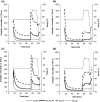Viscoelastic properties of sweet potato complementary porridges as influenced by endogenous amylases
- PMID: 29188034
- PMCID: PMC5694867
- DOI: 10.1002/fsn3.492
Viscoelastic properties of sweet potato complementary porridges as influenced by endogenous amylases
Abstract
Sweet potato (Ipomoea batatas L.) roots contain amylolytic enzymes, which hydrolyze starch thus having the potential to affect the viscosity of sweet potato porridges provided the appropriate working conditions for the enzymes are attained. In this study, the effect of sweet potato variety, postharvest handling conditions, freshly harvested and room/ambient stored roots (3 weeks), and slurry solids content on the viscoelastic properties of complementary porridges prepared using amylase enzyme activation technique were investigated. Five temperatures (55°C, 65°C, 70°C, 75°C, and 80°C) were used to activate sweet potato amylases and the optimum temperature was found to be 75°C. Stored sweet potato roots had higher soluble solids (⁰Brix) content in the pastes compared to fresh roots. In all samples, activation of amylases at 75°C caused changes in the viscoelastic parameters: phase angle (tan δ) and complex viscosity (η*). Postharvest handling conditions and slurry solids content significantly affected the viscoelastic properties of the porridges with flours from stored roots yielding viscous (liquid-like) porridges and fresh roots producing elastic (solid-like) porridges. Increase in slurry solids content caused reduction in the phase angle values and increase in the viscosity of the sweet potato porridges. The viscosity of the porridges decreased with storage of sweet potato roots. These results provide a possibility for exploiting sweet potato endogenous amylases in the preparation of complementary porridges with both drinkable viscosities and appropriate energy and nutrient densities for children with varying energy needs.
Keywords: complementary porridge; endogenous amylases; phase angle; sweet potato; viscosity.
Figures





Similar articles
-
Effect of sweet potato endogenous amylase activation on in vivo energy bioavailability and acceptability of soy-enriched orange-fleshed sweet potato complementary porridges.Food Sci Nutr. 2018 Apr 17;6(4):1119-1127. doi: 10.1002/fsn3.653. eCollection 2018 Jun. Food Sci Nutr. 2018. PMID: 29983976 Free PMC article.
-
Chemical, sensory and rheological properties of porridges from processed sorghum (Sorghum bicolor), bambara groundnut (Vigna subterranea L. Verdc) and sweet potato (Ipomoea batatas) flours.Plant Foods Hum Nutr. 2001;56(3):251-64. doi: 10.1023/a:1011193727687. Plant Foods Hum Nutr. 2001. PMID: 11442225
-
Effects of Different Temperatures on the Physiological Characteristics of Sweet Potato (Ipomoea batatas L. Lam) Storage Roots and Growth of Seedlings During the Sprouting and Seedling Period.Plants (Basel). 2025 Mar 10;14(6):868. doi: 10.3390/plants14060868. Plants (Basel). 2025. PMID: 40265776 Free PMC article.
-
Starch self-processing in transgenic sweet potato roots expressing a hyperthermophilic α-amylase.Biotechnol Prog. 2011 Mar-Apr;27(2):351-9. doi: 10.1002/btpr.573. Epub 2011 Mar 1. Biotechnol Prog. 2011. PMID: 21365786
-
Sweet potato: a review of its past, present, and future role in human nutrition.Adv Food Nutr Res. 2007;52:1-59. doi: 10.1016/S1043-4526(06)52001-7. Adv Food Nutr Res. 2007. PMID: 17425943 Review.
Cited by
-
Sweetpotato-based infant foods produce porridge with lower viscosity and aflatoxin level than cereal-based complementary blends.PLoS One. 2022 Oct 13;17(10):e0275593. doi: 10.1371/journal.pone.0275593. eCollection 2022. PLoS One. 2022. PMID: 36227913 Free PMC article.
-
Effect of sweet potato endogenous amylase activation on in vivo energy bioavailability and acceptability of soy-enriched orange-fleshed sweet potato complementary porridges.Food Sci Nutr. 2018 Apr 17;6(4):1119-1127. doi: 10.1002/fsn3.653. eCollection 2018 Jun. Food Sci Nutr. 2018. PMID: 29983976 Free PMC article.
References
-
- Adebowale, K. O. , & Lawal, O. S. (2003). Functional properties and retrogradation behaviour of native and chemically modified starch of mucuna bean (Mucuna pruriens). Journal of the Science of Food and Agriculture, 83, 1541–1546.
-
- Adenuga, W. (2010). Nutritional and sensory profiles of sweetpotato based infant weaning food fortified with cowpea and peasant. Journal of Food Technology, 8, 223–228.
-
- Amankwa, E. A. , Barimah, J. , Nnaji, C. O. , & Addai, L. O. (2009). Effect of fermentation and malting on the viscosity of maize‐soya bean weaning blends. Pakistan Journal of Nutrition, 8, 1671–1675.
-
- Bovell‐Benjamin, A. C. , Gichuhi, P. , & Abdall, M. (2004) . Bulk ingredients from three cultivars of sweetpotatoes: Composition and properties. Technical paper, Society for Automative Engineers, Warrendale, PA, 2004‐01‐2527.
-
- Cameron, T. B. , Heather, F. P. , & Dunn, M. L. (2009). Effect of preparation method on viscosity and energy density of fortified humanitarian food‐aid commodities. International Journal of Food Science, 60, 219–228. - PubMed
LinkOut - more resources
Full Text Sources
Other Literature Sources

